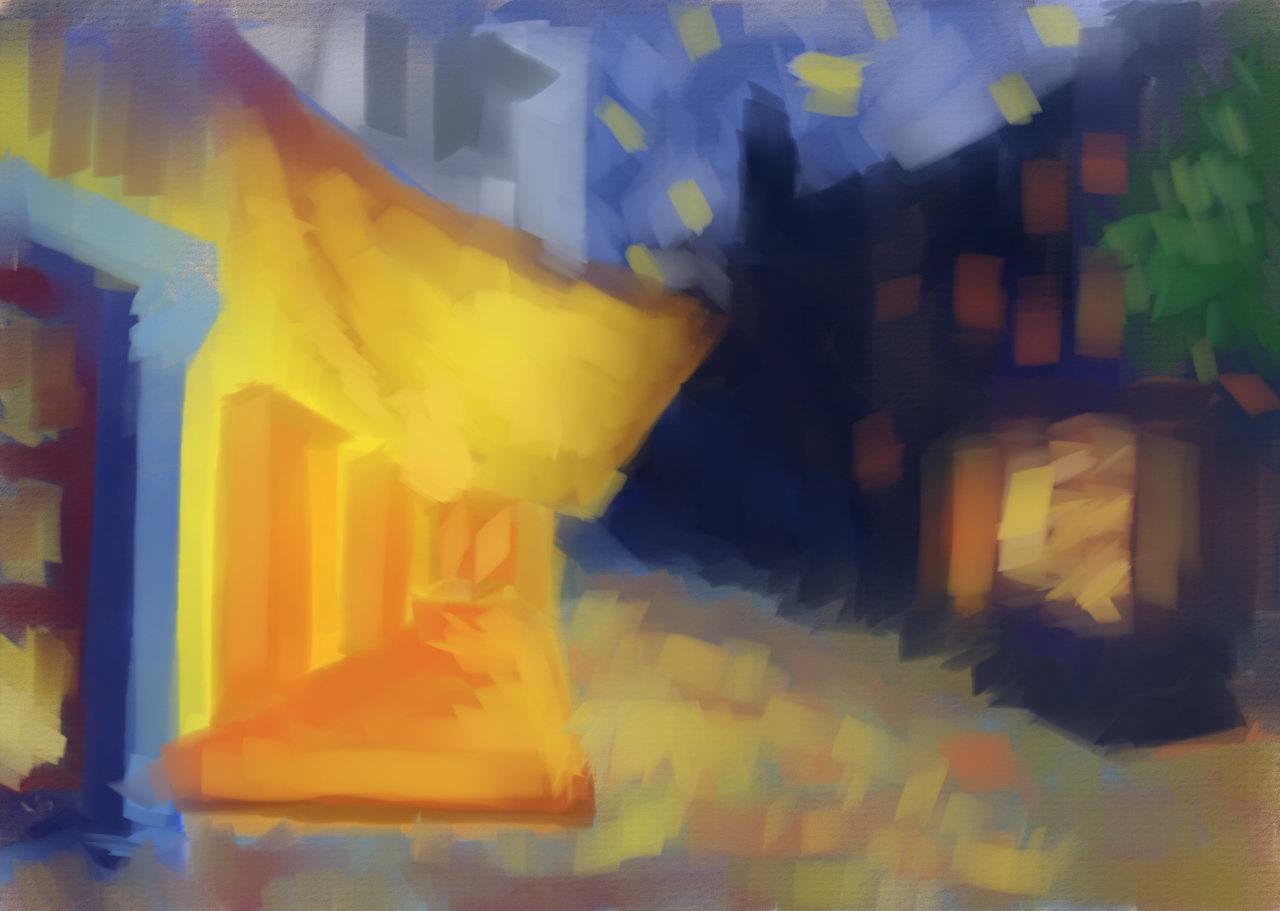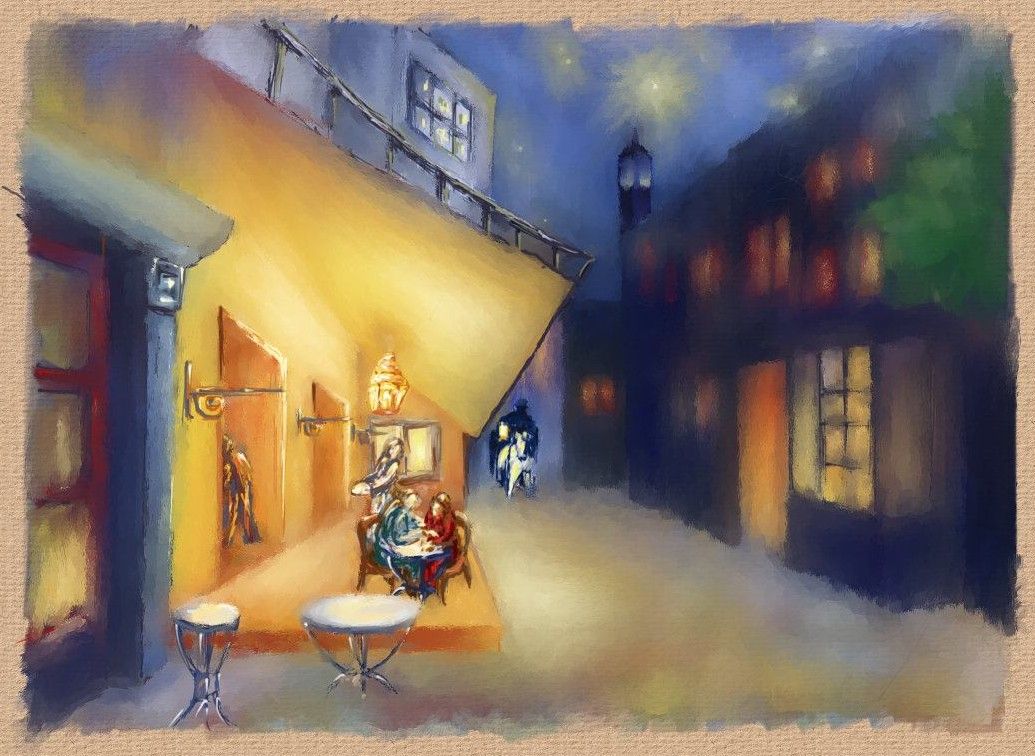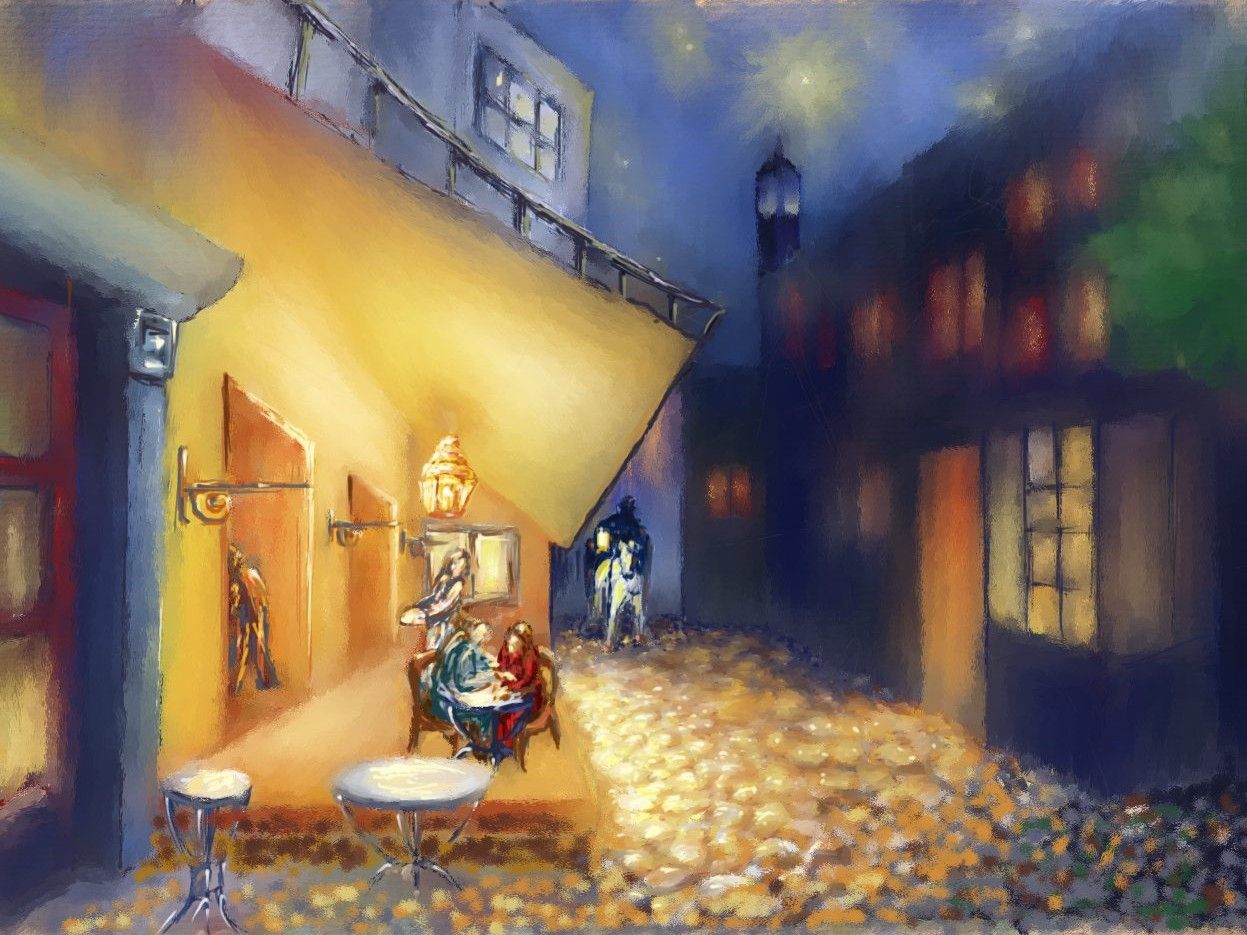Inspired by Vincent van Gogh's legacy.
And a song by Patrick Bruel.
Magical surrealism inspired
There is a story attached to this piece. It has ellements of past-present-and future in it, related to my real day-to-day-life. But that may be part of some unreal experiences. Inspired by Vincent van Gogh his 'Café Terrace at Night' and also by a French chanson, by Patrick Bruel, titled: 'Je te le dis quand même', which is the actual title of this digital painting. The titel translates to: "I'll tell you anyway." and in the song that part being: "Je t'aime." or translated: "I love you."
First I started with the paintknife tool in the MyPaint application. It is an Free Open Source digital painting program that mimics analogue tools and supports pressure sensitive drawing tablets. And there are some effects that can be achieved with it that are a bit more difficult to get right with the analogue equivalents. Also, it creates less of a mess and the paint is dry right away. Because of my profession as a Graphical Designer I started to use computer hardware as tools a long time ago, that being relative of course.
Started with prepress work using a Commodore C64. Now that will look almost crazy to some. All pixels, low resolution, but I did forsee a future in that, graphical design, digital press, imagine that...! It was somewhere half way the eighties of the previous century. When the best music ever was made. But I guess every generation has their own preferences set like that. It was at a youthclub that this first DeskTop Publishing project started. And in a later stage I moved to the Commodore Amiga. What a nice machine for the creative expression. Audio-visual, it was all there. PC? No off course not, have you ever worked with MS-DOS and Wordperfect...?
When short on cash, innovation saves the day
Graphic scanners were quite expensive back then, so I build one myself. Well, that sounds way more easy than it was actually. Old A3 matrixprinter, ow how I disliked that noise, removed the defect printing head and I had a great carriage for a scanning head. Moving rock steady, paper moving vertical in smal steps, that could do it. The Amiga had analogue ports, meaning they could be used to digitize voltage levels. And it served a safe 5+ Volt itself. Now, all I needed first was something to catch the light reflections with. There was a littke light, aimed at the scanning surface and added was a high speed and very light sensitive transistor.
A lot of trial and error, without internet, finding out how to print codes to the printer. That I did in AMOS Basic compiler, a nifty programming that I had bought for the Amiga. First scans were rubbish, patterns, only patterns, diagonal and nothing that even looked like a real scan of an image. And then while doing other stuff it hit me: timing and condensators acting like small batteries. Started to dive into that, reading about and adjusted the programming. And there it was the first 16 level greyscale image scan, quite unsharp still, but I did it! After that the fine tuning began. Making sure the focus cone was dark inside and had a very small opening. Started to use the 32 colour screen type and made a range of 32 bleuish-grays. It is one of the greatest computers I had experimenting with on several audio-visual levels.
Back to the future
Nowadays I use Linux and it took me some trial and error to get the graphic tablet working with MyPaint, but finally I did. And after a while I started to 'paint' the image in this post. It is about memories of past times that echo into the here and now. In my Van Gogh inspired work an old man returns after many years to that pub in Arles, France. As he grow old he started to reflect on his life as it went by. At some point it drew him back to a crucial turning point in his life. Arles the night, the pub, the terrace, where he broke up with her. Remembering every single word and that moment that he heared the carriage arrive. The clicking of the horses hooves on street cobbles softly echoing closer, like the ticking of a grandma's clock.
The wooden floor is creaking under his feet while he walks into the bar. A fusty smell is hanging around here, that and wine. It has not changed a lot since that day. The garcon acting nosy, almost bending over, not to miss a word, not anything of what was happening. She already had moved away from him at the table. No, he did not want to do the "It is me, not you", routine, and how was it possible that the more she was moving away, the more he felt his heart break? Trying to hold on to her, while he just told her in his long-winded way that they had become what they once made fun of. And as she got up to move towards the carriage he ordered to take her back to her hotel, he said: "And I still am going to say to you, one last time: Je 't aime."
He never saw her after that. Still rembering everything about her. The way she smiled, her voice, her laugh, her beautifull eyes and the way she seemed to be able to read his mind. It is all there, repentance, swallowed down with the last drop of coffee, time to move back for home, another thing to scratch from his bucket list. And as he walks over the squeaky floor to the exit of the pub a song starts to play: "Je te le dis quand même." It started to rain...
That was the story here is the painting
To wrap this post up, some stages of this digital painting that took me ages to complete. Well and at some point I still could maybe do more with it. There are certain similarities with the work by Van Gogh that for a big part inspired me. Yet it took its own twist and form with the story and the song added.
Have a good one!
Rough setup with the paintknive tool

Already taking shape

Zoomed in on some detail

Now them cobbles...

And there it is, the final version

artwork cc-by-sa @oaldamster